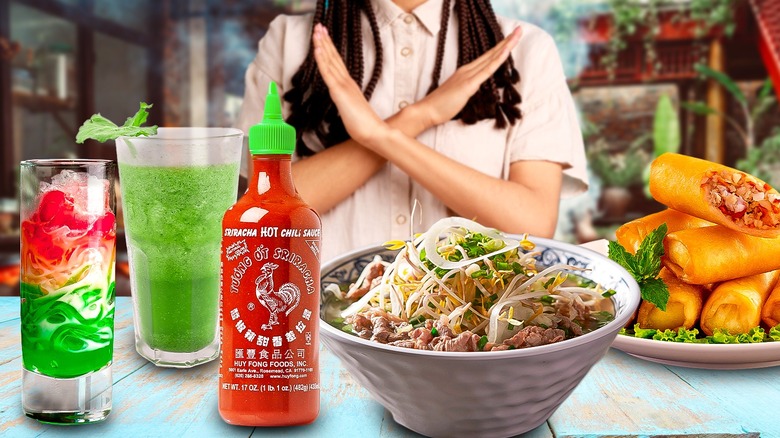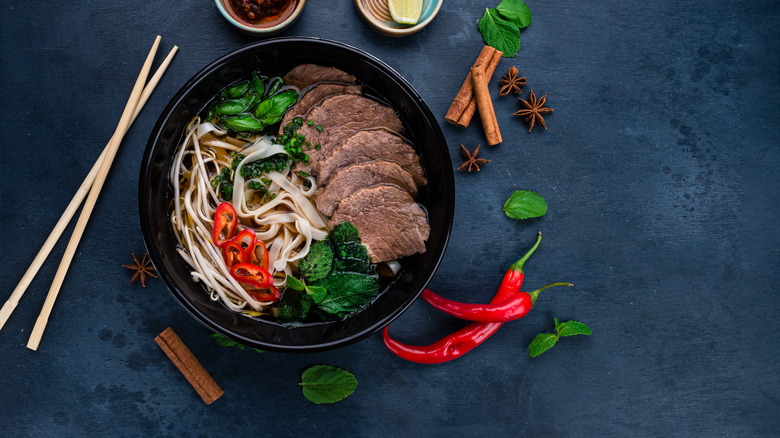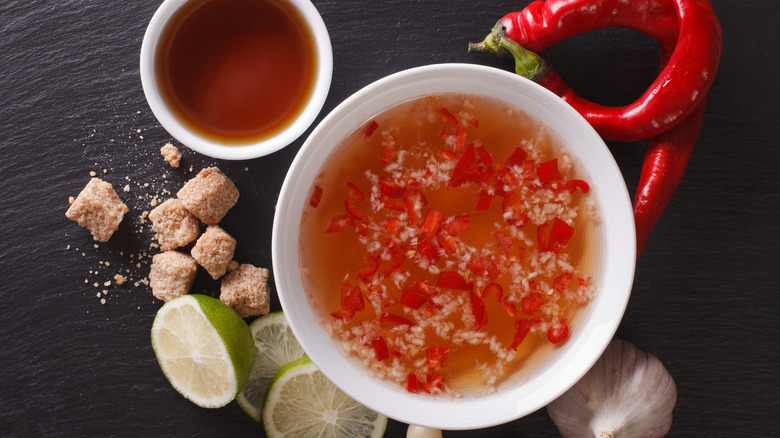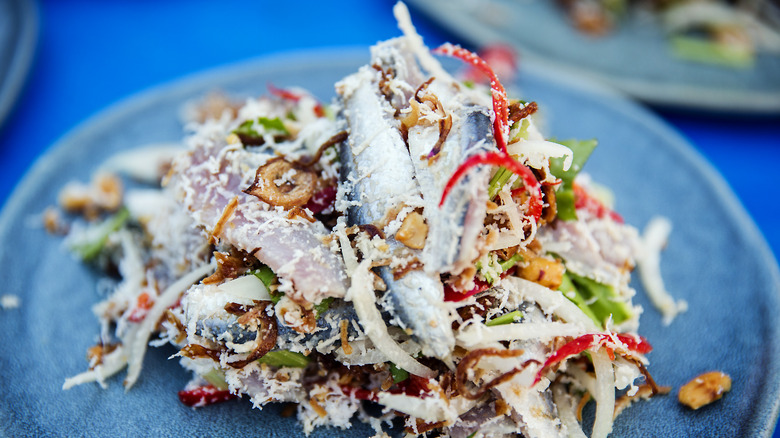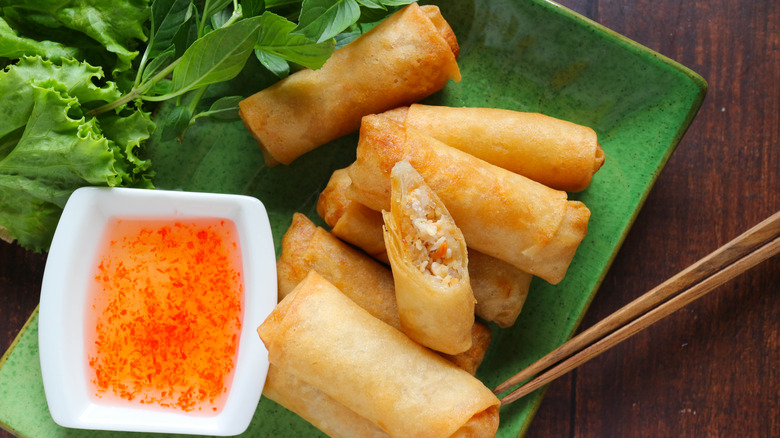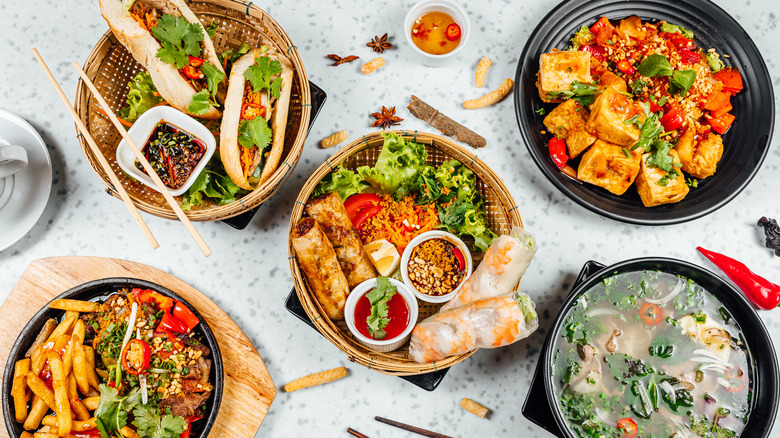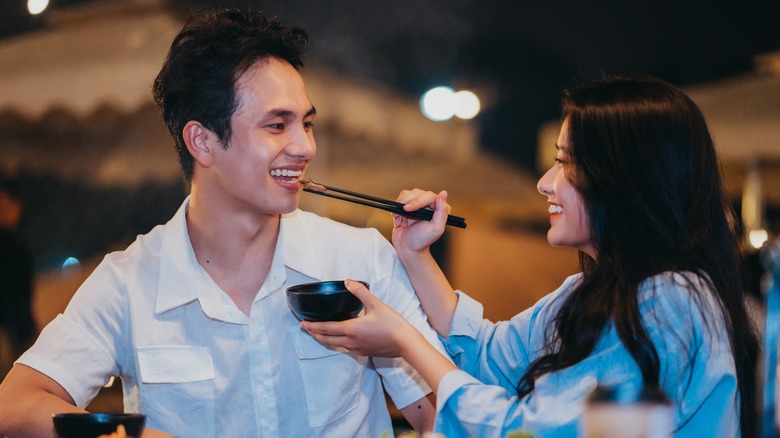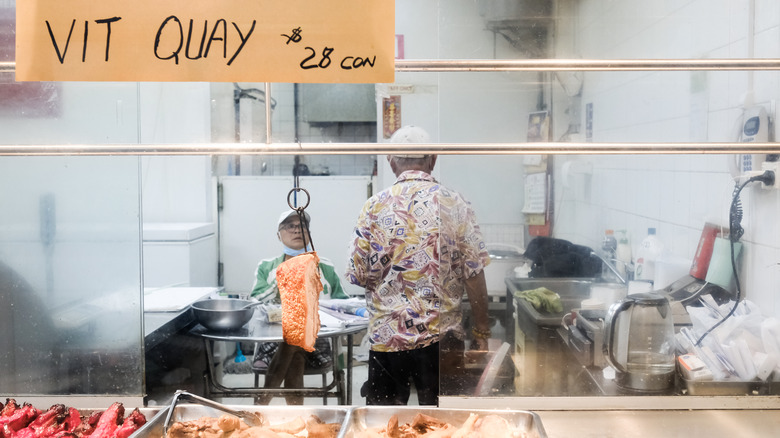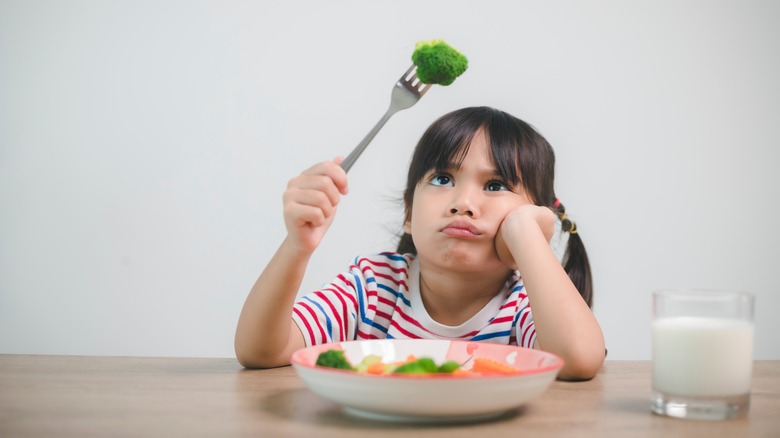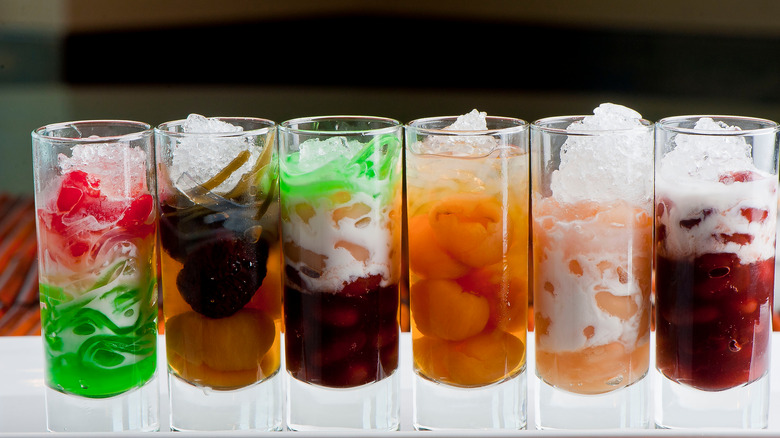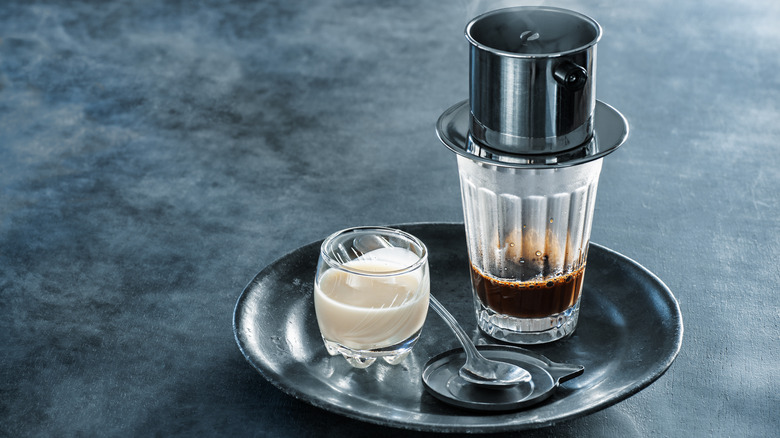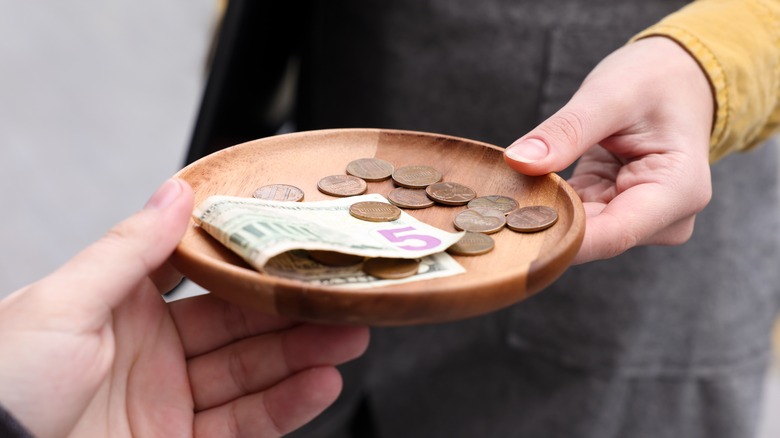12 Mistakes You Need To Avoid When Dining At A Vietnamese Restaurant
The Vietnamese diaspora was a reaction to a tumultuous war that shook a nation and spread its people across the world, including to America. Vietnamese restaurants are growing in number throughout the country, making the cuisine more and more commonplace. As Vietnamese food becomes a staple in cities beyond the major cultural hubs like San Jose, Houston, and New Orleans, the regional variants become more and more specific. For the unfamiliar, ordering at a Vietnamese restaurant can be overwhelming, especially when it comes to understanding certain dishes or eating practices.
Although it may seem mystifying, don't get stuck in the dark. Vietnamese food is delicious, exciting, and popular for a reason. While the ingredients, flavors, and names of dishes can be surprising, they are equally fresh and well-balanced. Avoiding a few common pitfalls and mistakes when eating at a Vietnamese restaurant will help you have a better dining experience, help you understand the cuisine, and make you a more satisfied eater.
Only ordering phở
It is said that the origins of phở began in the 19th and 20th centuries in the Nam Dinh province with a noodle dish known as xáo trâu that used the bones of water buffalo. French colonists in the region introduced cattle, which they would butcher for prime cuts and discard the remainder of the carcass. Locals began to use the cow discard to make their noodle soup, and phở was born.
What began as a peasant food is now one of the most ubiquitous and well-known noodle soups in the world. Phở is a noodle soup made with beef bone broth, thin bùn noodles, and varying cuts of beef. While it is undeniably delicious and certainly deserves its flowers, phở does not represent the wide spectrum that is Vietnamese food. Because it is such a household name, phở is sometimes the only thing unfamiliar diners order, which is a mistake when eating at a Vietnamese restaurant.
Noodles are incredibly important and pervasive to Vietnamese cuisine and culture, and there are many shapes and styles from which to choose beyond the one or few you may be familiar with. If you've only ever tried phở, try to branch out to other soups that your favorite Vietnamese spot might offer, such as the bright red crab-and-tofu-laden bún riêu, or the beautifully balanced pork and shrimp noodle soup, hủ tiếu. You might find yourself a new usual order to rave about.
Not asking for extra sauce and garnishes
Vietnamese cuisine strives to strike a balance between spicy, sour, bitter, salty, and sweet flavors in foods that are both warming and cooling. But, of course, not all restaurants are created equal, and sometimes you've got to ask for a little extra to ensure all your bases are covered and to enjoy your food properly.
It's not entirely uncommon for a Vietnamese restaurant to serve chả giò (fried pork and shrimp imperial rolls) with too few leaves of lettuce to wrap them with. Maybe the bún bò Huế (spicy beef and pork noodle soup) you ordered doesn't have enough cilantro or onions to garnish the bowl. Or maybe your bánh xèo (turmeric rice flour crepe) didn't come with enough nước chấm to cover the entire thing.
Because Vietnamese cuisine is so balance-driven and ingredient-based, missing even one component — or not having enough — can make the food taste completely different than it should. Don't be afraid to ask! It's likely the restaurant staff simply forgot or made a mistake or is trying to save money. Make sure to be gracious and patient when asking for anything beyond what was given, and much more often than not, the staff will be happy to accommodate. Even if they can't, the worst they can say is no.
Drowning your food in hoisin sauce and sriracha
Common tabletop condiments at many Vietnamese restaurants include a jar of chili paste and bottles of fish sauce, sriracha, and hoisin sauce. While these ingredients can be useful additions to food, they are ultimately flavoring agents that have the potential to overpower. A common mistake to avoid at Vietnamese restaurants is adding too much sriracha or hoisin sauce to their meal — especially phở.
Phở is a balancing act. A good bowl of phở should be hearty and slightly sweet in the broth, bright and fragrant from the herbs, and savory and rich from the meat. Other ingredients may be added to enhance the elemental flavors of phở, such as bird eye chili, lime, or fish sauce. While some purists may argue that hoisin sauce and sriracha shouldn't be added to phở, there really is nothing wrong with doing so, so long as the sauces don't take the foreground.
Phở broth is made by simmering beef bones for hours — sometimes a day or so — with aromatic spices like cassia, black cardamom, clove, and star anise. The result is a beautifully delicate liquid rich in nuanced and subtle flavors. To add strongly flavored sauces like hoisin and sriracha to the point of excess is to do a disservice to the labor-intensive process. Taste your broth first, and be sure it needs something extra. Add enough to enhance the flavor of the broth, but do so sparingly.
Skipping the appetizers
There's much to love about Vietnamese small plates. A cuisine driven by fresh meat and produce, Vietnamese food has no shortage of delicious rolls, salads, and finger foods. Thus, it's important not to skip to the entrees too quickly, especially if you're eating with a group.
Many Vietnamese dishes have made their way to the hearts and minds of the American palate, such as the aforementioned chả giò and the seemingly universally loved gỏi cuốn, or shrimp rice paper spring rolls. But others sometimes fall by the wayside because of unfamiliarity, despite how delicious they may be.
One of the highlights of Vietnamese cuisine is the salads, most of which are dressed with nước chấm, a cornerstone Vietnamese sauce made with fish sauce, lime juice, and sugar. Salads such as the gỏi gá — a mixture of shredded cabbage, poached chicken, crispy shallots and garlic, Vietnamese coriander, and nước chấm — are both refreshing and have very high shareability.
Rolls are also a significant part of Vietnamese dining, with styles and ingredients that range from meaty and deep-fried to leafy and herbaceous. The cuốn diếp is a slightly more obscure Vietnamese roll that uses a mustard leaf as its outer vessel filled with rice vermicelli, herbs, and veggies or meat.
Not dressing your chả giò
Chả giò are deep-fried Vietnamese spring rolls made with a hearty filling that can vary from restaurant to restaurant but usually consists of ground pork and shrimp, rice noodles, mushrooms, and chestnuts, carrots, kohlrabi, or jicama. The mixture is seasoned with fish sauce and sugar and wrapped in moistened rice paper before it is deep fried, causing the rice paper shell to puff and crisp. The result is a textured and savory roll that may be served as an appetizer or as part of an entree.
When served as an appetizer, chả giò are always plated alongside large leaves of lettuce, pickled carrots, and daikon (đồ chua), nước chấm, and herbs like cilantro, Thai basil, and mint. Unfortunately, the now-antiquated Western phenomenon of garnishing food with purposeless produce still sticks with American diners from time to time and often leads to the accompaniments of chả giò going unutilized.
Chả giò is meant to be eaten in a very particular way, which reflects the Vietnamese concept of striking balance. The fried pork in the chả giò is considered heating and is meant to be balanced out by cooling elements. This is where the fresh produce comes in. Wrap your chả giò in a leaf of lettuce and fill it with the picked herbs, which help cool and brighten the savory and rich rolls. Add some daikon radish and finish by dipping the garnished chả giò in the sweet and tangy nước chấm.
Only ordering one carb base
As mentioned earlier, noodles in all shapes and styles are vital to Vietnamese cuisine. But that's not to say there aren't other staple carbs that are just as delicious. Vietnamese food is rich in various breads, rice, and cakes that serve a different purpose in each dish. When deciding on your order, try to strategize by picking several dishes that involve different carbs so that your eating experience is dynamic and varied.
If the restaurant you're dining at has a wide variety of choices, from bánh mì (Vietnamese French bread sandwiches) to thịt kho (caramelized pork belly and eggs with white rice), try to order something from each category. Covering all your bases, including noodles, rice, and bread will help make for a unique dining experience. Not only will the textures and flavors of each dish be different, so will the way they are eaten — i.e. with a spoon, chopsticks, or by hand.
This will especially be desirable when dining with guests. Ordering several dishes with the same or similar carbohydrate bases isn't as engaging, as everything will have a similar mouthfeel. Try to spread yourself and your guests as widely across the menu as possible.
Forgetting to ask for recommendations
If you're stumped on an order, don't fret. You're never alone at a restaurant, even if you're by yourself. Sometimes, the most overlooked resource when ordering at a restaurant is the restaurant's staff. After all, no one knows the food better than the people who work there.
Oftentimes, a Vietnamese restaurant will specialize in a specific region or variety of dishes that may not be readily obvious to the inexperienced eater. The restaurant may serve other Vietnamese items on its menu or even other cuisines, but when prompted, the staff will almost always let you in on their preferences. This advice is not so much exclusive to Vietnamese restaurants as it is specific to dining in general. Part of being a curious eater is being unafraid to ask what is good.
A great way to avoid this common mistake at Vietnamese restaurants is to say yes when the server or person taking your order asks if you have any questions about the menu. It's never a bad idea to ask the staff what their favorite dishes on the menu are. Rather, this will show the staff that you are open to trying something new and delicious and that you value their opinions. At the end of the day, the folks who make and serve the food are the real experts, and you really can't beat free advice.
Missing out on the restaurant's signature item(s)
You may find that the Vietnamese restaurant you're visiting is named after a particular food. Many have the words "phở" or "bánh mì" in the name, and it's important to note that this is rarely arbitrary. While sometimes a play on words, like "Phở King," is meant to draw attention to itself, usually the referencing of a particular dish in the name of a Vietnamese restaurant is a signal that the particular item is very good there, and yes, you should order it.
Cơm Tấm Ninh Kiều, a restaurant in the Bronx, New York, is a no-frills home-style hub for Vietnamese fare of all sorts, but there is one menu item it does arguably better than all the rest: the eponymous pork and rice plate with which it shares a name. This Southern Vietnamese dish — which consists of a grilled pork chop, an egg and pork patty, a shrimp dumpling, shredded pork skin, and sunny-side-up eggs — is noticeably different from the typical offerings you might find at most Vietnamese restaurants. But its delicious idiosyncrasies are obviously so important to the owners that they used it as a namesake.
This is all to say, don't be afraid to read into names a little deeper. Look for a common thread between a restaurant's name and menu for what shouldn't be missed. And, again, when in doubt, don't forget to ask the staff.
Being picky
Vietnamese food encompasses a wide range of ingredients, some of which can be found right here at home and others that are wholly unfamiliar to the Western palate. Ingredients like congealed blood, sea snails, and pork intestines may not sound extremely appealing to some diners, but they certainly have their place in Vietnamese cuisine for a reason.
It's important to enter any dining experience with an open mind. With the exception of dietary restrictions and allergies, unfamiliar Vietnamese should not be shied away from simply because you haven't tried them before. Say you visit a restaurant that specializes in a regional Vietnamese dish known as bún đậu mắm tôm, a dish that originates in Hanoi. Bún đậu mắm tôm consists of fried tofu, pork intestines, blood sausage, rice noodle cakes, and herbs served with the cornerstone Vietnamese sauce, mắm tôm, made of fermented fish paste. The smell of the mắm tôm can be extremely strong, but the taste is impossibly rich in umami.
There's no harm in experiencing a new ingredient, whether it be an animal part or a vegetable. If you've tried something for the first time and decided that it's not for you, that's totally fine. The important thing is having tried at all. On the other hand, you never know when you might discover a new favorite flavor or ingredient.
Skipping dessert
Vietnamese cuisine has some irresistible desserts. Some desserts, like bánh flan or creme caramel, are rooted in the pastry traditions of France, deriving from the days of French colonialism in Vietnam. Others, like chè chuối or banana in tapioca pudding, are more referential to traditional Vietnamese flavors. Local ingredients like pandan, coconut, and banana influence the flavors and textures of desserts from pre and post-colonial Vietnam.
Whatever you find at the Vietnamese restaurant you happen to have the pleasure of visiting, make sure you don't leave without at least giving the dessert menu a once-over. Sticky rice dishes formed into banana cakes, called bánh tét, are a much-loved dessert often gifted around the holidays. Cold and refreshing desserts like chè thái, a Vietnamese fruit and jelly cocktail served over ice, are the perfect cap to a big meal that won't fill you over the top.
Sleeping on the drinks
Vietnam is known for fresh and delicious food, of course, but its beverages are just as enticing. In Vietnam, most drinks are served over ice — a practice that harkens back to the days before refrigeration. Thus, many Vietnamese drinks are ice cold and refreshing, making them great partners to steamy dishes and days alike.
Depending on the Vietnamese restaurant you're dining at, you'll likely find a variety of different drinks to choose from. If you're lucky, the restaurant might serve beverages made from fresh ingredients, such as young coconut water drained right from the green husk or freshly pressed sugarcane juice with lime. If you're slightly less lucky, you might find these drinks on the menu served from bottles or cans. They're still delicious, just not as grassy and vegetal.
It would be remiss not to mention coffee as a must-have Vietnamese beverage. Cà phê sữa đá, or Vietnamese iced coffee, has become so widely popular it is sometimes found these days in American cafes or pre-mixed in grocery stores. In its traditional format, hot coffee is brought out mid-drip, filtering through a pour-over device called a phin. It's served alongside a glass filled with ice and sweetened condensed milk. Once the coffee completely passes through the filter, it's intended to be poured over the ice and milk and stirred to combine. Finally, if you can find them, don't miss out on the rare Vietnamese beers like Bia Saigon, 333, and Bia Hà Nội.
Not tipping
Unfortunately, Asian restaurants in the United States have been indiscriminately stigmatized as "cheap." This is an unfair stereotype that has led to many Western diners expecting quick and seamless service for bottom-of-the-barrel prices — an unrealistic expectation, especially in today's inflated food and service costs. Sometimes, this means that not only is food expected to be cheaper, but so is labor.
Vietnamese food, like any other cuisine, takes a significant amount of time, effort, skill, and labor to put together. Therefore, there is no reason that restaurant staff at Vietnamese restaurants should be tipped any less than those at an Italian or French restaurant. Make sure that you are tipping based on the service you receive, not on the cuisine or culture. At a minimum, a reasonable tip in the contemporary restaurant landscape is 15%, but 18 to 25% is preferred. This is true even for takeout.
Restaurant workers, like everyone else, are trying to get by. If you truly enjoyed your meal and the service you received, make sure you let the staff know by leaving a generous tip at the end of it.
